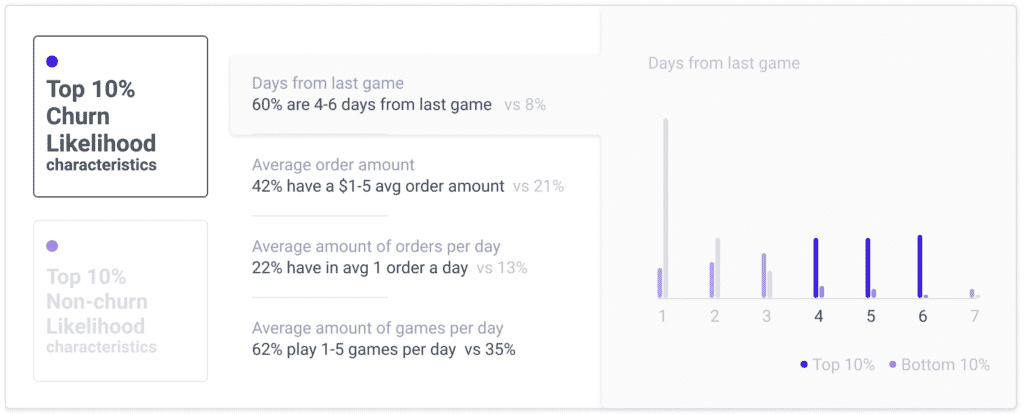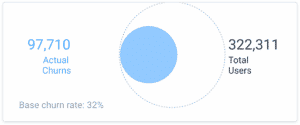Every app developer knows that the most important metrics when developing an app are engagement-related. After all, the app developer mantra is “engage first, monetize after.” In a constant battle for user time, developers need to keep their users engaged and happy while monitoring reduced engagement and churn rates. There is nothing more frustrating for a developer than seeing their user base bleeding out of the app (aka, DAU churn) without understanding why it happens and how to stop it.
This 3-step process is a framework for app developers to address the problem of user churn and do something about it as quickly as possible.
1. Identify (who)
2. Segment (why)
3. Treat (how)
1. Identify – who is likely to add to our DAU churn?
Good news! In most cases, DAU churn doesn’t happen spontaneously and there is usually a pattern that precedes a user’s churn.
The bad news … users are different, and the patterns are usually not obvious. The amount of data gathered and the complexity of getting into an accurate identification requires the help of machine learning predictive analytics capabilities and the creation of a churn likelihood prediction models that will output the users that are in the highest risk.
What exactly should you predict?
We see great results with models that are predicting how many users from the active user base are likely to leave the app in the following week.
While a single week may seem a short window, for most apps a break for this long can mean the user has lost interest permanently.
2. Segment – why are they likely to churn?
While two users could have the same likelihood to churn, the reasons they might churn could be completely different. To provide a correct and personal treatment (spoiler for step 3), we need to understand why a user is likely to churn.
As part of the outputs of Step 1, you should also understand what are the top features that drove the prediction on a user level.
The majority of apps would find the following segments as relevant:
- Decrease in activity – Changes in core engagement metrics.
- Friction – When the user is having challenges with the apps (an example: difficulty to perform a task or lose streak in gaming).
- Content – When a user finds it challenging to find content that is relevant for him.
- App trend – Seasonality and app maturity trends.
- Product – Platforms/versions that users are struggling with.
Another layer of segmentation in DAU churn analysis should include how valuable the user is for you. We can’t emphasize more on how important it is to be mindful of the user value. When a VIP/HV user churns, it’s a lot more painful and impactful for the business.

3. Treatment – how can we keep them with us?
After we created our segmentation and understood what is driving the user to churn, we should think about ways to improve. Below are some examples of how predictions can inform which channels to activate.
CRM
CRM tools, like in-app notifications, push notifications and emails coupled with relevant offerings and creative based on the previous segments, can help to engage and retain users that have gone dangerously dormant. However, make sure that what you offer isn’t so attractive that it would have a future negative impact on the monetization or product economy
Performance marketing
While CRM activation might not cost additional dollars per campaign and performance marketing does, if your users are already decreasing in engagement they are less likely to respond to CRM communications. By using highly targeted performance marketing channels, you can improve the reach of your message.
Product
Use the trends recognized to improve your product and understand where your weaknesses are. It could be on specific platforms or versions, it could be some part of the user journey that requires more work, or the level/amount of content you provided.
Additional considerations in analyzing DAU churn
Threshold setting
It’s highly critical to remember that a model produces a score, but it’s up to you to decide where you would like to make the cut off. The goal is to find just the right point where the ratio between true positives and false positives makes the most sense.
Start conservative to limit the amount of false positives and then gradually scale.
Baseline:

Threshold setting:

Test/Control
Every change/treatment that you implement should be measured correctly (statistically correct!) using a Test/Control methodology. Keep in mind that there could also be a long term effect to every change that you make, so quiet periods after the test and longer test windows are highly recommended.
“Already got”
Keep an “already got” list, a list of users that already enjoyed your treatment once and exclude them from future offers (or at least from the same one) to make sure users are not exploiting your DAU churn reduction strategy.
If you want to see how Pecan can identify which users are likely to churn, segment them based on affecting factors, and prioritize preventative actions you can take, request a demo and we can help you set up your first predictive model!



